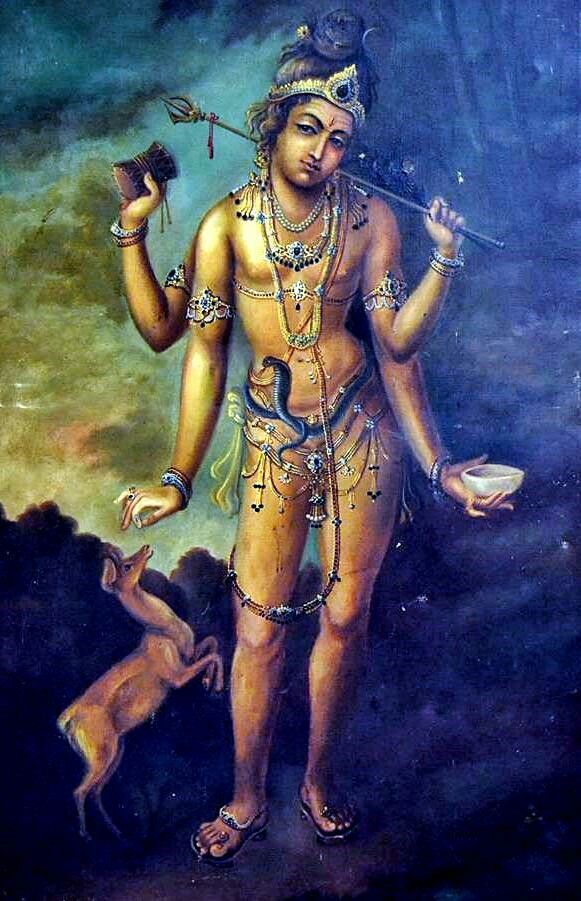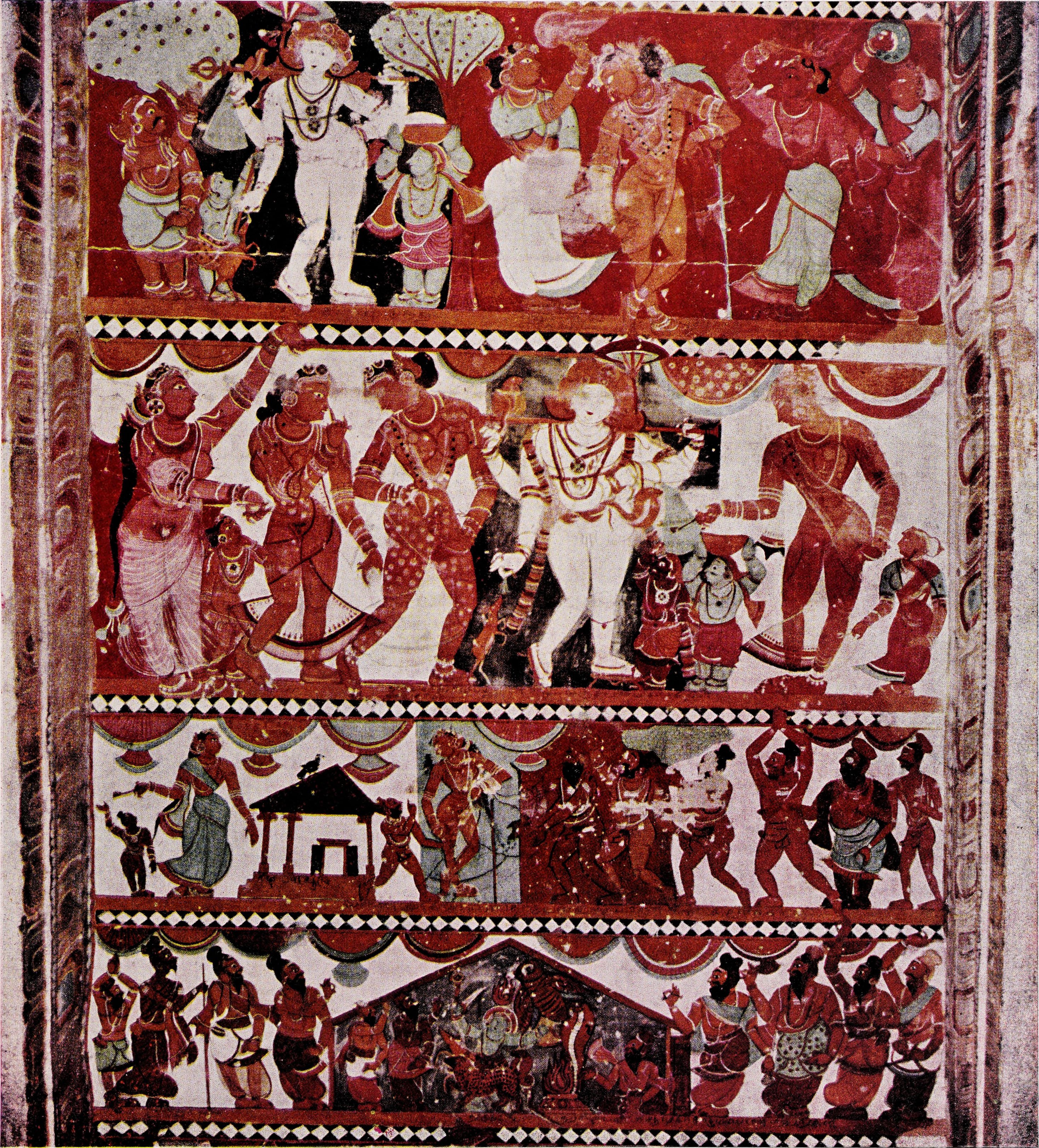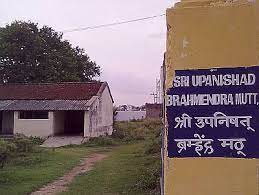mAra kOti kOti lAvanya- Arabhi – Obeisance to Lord Shiva
न जानामि योगं जपं नैव पूजां। नतोऽहं सदा सर्वदा शंभु तुभ्यं॥
जरा जन्म दुःखोद्य तातप्यमानं॥ प्रभो पाहि आपन्नमामीश शंभो॥8॥
(Sloka No 8 –
“Rudrashtaka” of Gosvami Tulasidas)
na
jAnAmi yOgam japam naiva pUjAm nathOham sadA sarvadA sambhu thubyam |
jarA janma dhukhOdhya thAthapyamAnam prabhO pAhi ApannamAmIsa sambhO ||
Meaning: I know neither yOgA nor jApa nor worship. All I know is to be devoted to you O Lord Shambhu. Save me from this bondage/misery of old age, death and birth.
Prologue:
The subject matter of this blog post is the composition “mAra kOti kOti lAvanya” of Muthusvami Dikshita found documented in the Sangita Sampradaya Pradarshini (“SSP”) of Subbarama Dikshita, which is rarely encountered on concert platforms. The sibling Arabhi composition in the SSP, “Sri Sarasvati Namostute” on the other hand is fairly ubiquitous and is typically taught to learners as one of the early kritis, for abhyAsA.
Records and accounts indicate that this composition “mAra kOti kOti lAvanya” has been rendered in the past and has also been part of the oral tradition but yet today it is rarely heard. In this blog let us get reintroduced to this composition and in the discography, section look at the renderings of this composition by two masters from the past. And I would seek to argue that this composition is immensely capable of an expanded treatment but yet inexplicably it is not been presented so by present day performers.
Let us first look at the lyrical aspect of the composition followed by the musical aspects and the related discography.
The Composition:
pallavi
mAra kOTi kOTi lAvaNya mAM pAlaya
(madhya stayi madhyama to mandhara pancama and to madhya pancama)
dhIra-agragaNya vAsukI valaya
(madhya dhaivatha to tara sadja and back to madhya sadja)
anupallavi
dArukA vana tapO-dhana taruNI mOha-AkAra bhikshATana vEsha dhara Sankara
(madhya dhaivatha to tara madhyama and back to madhya sadja after descending upto mandhara dhaivatha)
caraNam
viraktAnAM vidEha kaivalya dAna vicakshaNa -bhaktAnAM-abhaya pradAna
virinci-Adi sakala dEva-upAsyamAna – vibhUti rudrAksha-abhimAna
paraSu mRga-agni kapAla DamarukaM dadhAna -parama-advaita tAtparya-anusandhAna
para vAma dEva-Adi sakala virAjamAna – parama-ISvara guru guha samAna bhAsamAna
Meaning
pallavi
mAra kOTi kOTi lAvaNya – O one handsome as crores and crores of (i.e. countless) Manmathas!
mAM pAlaya – Protect me!
dhIra-agragaNya – O foremost among the courageous!
vAsukI valaya – O one wearing the snake Vasuki as a bracelet!
anupallavi
dArukA vana tapO-dhana taruNI mOha-AkAra – O one whose form enchanted the wives of the sages of the Daruka forest!
bhikshATana vEsha dhara – O one bearing the guise of a mendicant!
Sankara – O causer of welfare and good fortune!
caraNam
viraktAnAM vidEha kaivalya dAna vicakshaNa – O the foremost at giving videha-mukti to the dispassionate!
bhaktAnAM-abhaya pradAna – O one who bestows protection to devotees!
virinci-Adi sakala dEva-upAsyamAna – O one adored by all celestials beginning with Brahma!
vibhUti rudrAksha-abhimAna – O one who adores (wearing) vibhuti (sacred ash) and Rudraksha!
paraSu mRga-agni kapAla DamarukaM dadhAna – O one holding the axe, antelope, fire, skull and drum!
parama-advaita tAtparya-anusandhAna – O object of contemplation for understanding the meaning of supreme non-dualism!
para vAma dEva-Adi sakala virAjamAna – O resplendent one with many great forms such as Vamadeva!
parama-ISvara – O supreme lord!
guru guha samAna bhAsamAna – O one as effulgent as Guruguha!

The Lord as Bikshatanamurti as conceptualized by the artist Sri Siddhalinga Swami of Mysore
Lyrical aspects of the Composition:
The following points merit our attention:
- At the very outset it has to pointed out that there are no internal, external or collateral evidences to demonstrate that this composition even remotely pertains to a particular deity or ksetra. Therefore any attribution of this composition to a particular ksetra is purely speculative devoid of hard evidence.
- Dikshita first begins the composition in the pallavi by paying obeisance to this beautiful form of the Lord, at the very outset, whose identity he reveals only in the anupallavi when he explicitly refers to the “bikshatana” form of Lord Shiva by invoking the puranic lore of Lord Shiva and Lord Vishnu coming together to subdue the vanity of the sages of the Darukavana ( forest of deodhar trees).
- The usage of a word twice consecutively such as “kOti kOti” in a lyrical device which is found used by Muthusvami Dikshita in “Sri Subramanyaya Namaste” in Kambhoji for example where the word “namaste” as well as “koti” are used twice over consecutively to mean that its being meant as many times over.
- While this kriti is an adulatory paean to Lord Shiva, the lyrics can be said to be propitiating Lord Shiva of the “Bikshatana” form. Lord Shiva is said to have 64 forms such as Linga, Vrushabarudha, Dakshinamurti, Kalasamharamurti, Bhairava, Tyagaraja or Somaskanda, sadAshiva and others of which the “Bikshatana mUrti” is one form.
- The reference in the lyrical portion of the anupallavi being “dArukA vana tapOdhana………………..vEshadhara sankara” pertains to the mythological lore of Lord Shiva assuming the form of a handsome mendicant to enchant the wives of the Sages of Darukavana, so as to teach those sages a lesson. This mythology finds reference in the stala purana of Chidambaram and Thiruvenkadu (Svetaranyam or Adi Chidambaram). The blog header is a panel from the Chidambaram temple describing this instance when Lord Shiva took the form of Bikshatana and Lord Vishnu took the form of Mohini to teach the sages of Darukavana, a lesson.
- It may be pointed out that this lore of Lord Shiva taking the form of a bikshatana is found referenced by Dikshita in two other compositions as under:
- “dArukAvanastapOdhana” in the Bilahari kriti “hAtakesvara samrakshamAm” and
- “dArukAvana tapOdhana kalpitha” in the Caturdasa ragamalika kriti “Sri Visvanatham Bhajeham” being the Saranga raga portion of the said composition.
- Residents of Mylapore, Chennai may recall that the Panguni Festival in the Sri Kapaleesvara Temple features the Lord in this form with a bowl as a seeker of alms on the 9th day of the festival. In fact, Papanasam Sivan who composed the well-known Kambhoji song “kAna kann kOdi vEndum” on the “adhikAra nandhi sEva” of the Lord of Mylapore also sang “picchaikku vandhIrO” set in raga Surati as well, on this Bikshatana murti procession of Mylapore.
- Amongst the quartet of Tamil savants three have sung tEvArams on this form of the Lord as a seeker of alms and the following are few instances:
- Thirujnanasambandhar – Hymn on the Lord at Tiruvalachuzhi.
- Appar/Tirunavukkarasar – hymn on the Lord at Tiruvottriyur
- Sundaramurti Svamigal – hymn on the Lord at Tiruvarur
- The Bikshatana form of Lord Shiva is a risqué imagery and again Dikshita as is his wont brings in the iconography of this form in the lyrical portion as a pen picture for us:
- His inestimable beauty of form “mAra kOti kOti lAvanya”- being akin to the beauty of innumerable manmatAs,
- His enchanting handsomeness “mOhAkAra” – which entranced the women folk of Darukavana.
- His predilection for “vibhUti” and “rudrAksha” beads which he wears as ornamentation along with vAsuki the serpent to adorn his body.
- “paraSu mRga-agni kapAla DamarukaM dadhAna” – enumerating the pick-axe, deer, fire, skull and the drum. Curiously the bhikshadana form is seen to hold only shUlA (Trident), kapAla (skull), the antelope and the bowl for alms in the 4 hands, whereas Dikshita identifies 5 objects as being held by the Lord.
- The lyrical portion “guruguha samAna bhAsamAna” is reminiscent of “guruguha samAnavaraOjasE” which occurs again in “Hastivadanaya Namastubhyam” in Navaroj.
- The raga mudra is beautifully interwoven in the lyrics at “mOha-AkAra bhikshATana”. Dikshita has adroitly woven in the same (‘sUchita’ raga mudra) much like how he has done in “citpratibimbE galajitasankE” (“Sri Matah Sivavamanke” in Begada) and “samAnavara OjasE” in “hastivadanaya namstubhyam” in Navaroj. Dikshita has enmeshed the raga mudra Arabhi in his other two compositions in the same raga as under;
- “samsAra bhItyApahE” – in “Sri Sarasvati Namostute”
- “srutajana samsara bhItyApaham” in the Arabhi raga portion of “Sri Visvanatham bhajeham”, the caturdasa ragamalika
- While these two instances above belong to the same category from a usage/meaning perspective, Dikshita has very beautifully invoked the raga name in the instant case of “mAra kOti kOti” by placing the mudra at the junction of two words which together describes Lord Shiva as the enchanting mendicant.
- As always, the composer’s colophon “guruguha” appears explicitly in the final madhyama kala sahitya section at the fag end of the composition.
Discography:
In this section I present versions of the composition as available in the public domain so that we can have an idea as to the melodic contours of this rarely encountered composition.
And I start with the version of Sangita Kalanidhi Alathur Srinivasa Iyer. Before we hear his rendering, it would be interesting to divine the likely source of the pAtham of his. We do know for sure that the Alathur Brothers namely Sri Sivasubramanya Iyer and Sri Srinivasa Iyer were associated with the legendary Vaineeka Sri Sambasiva Iyer. Sri Sambasiva Iyer was a Srividya Upasaka and which may likely explain the fact that compositions like “Sri Matah Sivavamanke” in Begada was part of his repertoire which he may have passed on to Alathur Brothers. This kriti “mAra kOti kOti lAvanya” too could have been part thereof.
In this recording Alathur Sri Srinivasa Iyer renders “mAra kOti kOti lAvanya” prefacing it with a succinct alapana. Attention is invited to how the veteran pivots the raga anchoring it firmly at pancama (with the rishabha as the ending note for his phrases) and then tara sadja and tara rishabha notes and how he caresses the dhaivatha note ever so gently, summarizing the raga every now and then, thus presenting the unalloyed Arabhi of yore for us even as he concludes it with the fluid madhyama kala akara passages . The way in which the raga vinayasa is expounded by the legend, is a veritable lesson for a student of music.
The accompanist though not indicated in the sleeve notes, appears to be Vidvans Lalgudi Jayaraman on the violin and the legendary Palghat Mani Iyer on the mrudanga.
Presented next is a rendering of the same composition by the veteran music composer Tanjavur Sankara Iyer from a private chamber recital.
The Musical Aspect of the Composition:
I choose to present the musical side of this composition finally in this blog post to highlight, the hidden nuances of the composition as documented in the SSP which have hitherto not been fully presented. I would further argue that with greater fidelity to the notation found in the SSP, the composition’s true beauty can be envisioned and brought out by performers today.
- The composition begins with an elongated madhyama note as a svarakshara, a rarity in Arabhi, where pancama is always a strong note or jiva svara. The composition is found notated in 1 Kalai misra jhampa tala and 2 ½ aksharas of the tala is found allocated to this opening madhyama note. The commencement on the dhirgha madhyama making it a graha adds a singularly different complexion to the rendering and the texture of Arabhi of this composition. In my opinion, as notated by Subbarama Dikshita, this opening madhyama is not an oscillated note but a steady, prolonged, deep and sonorous dhIrga madhyama note. This madhyama graha note of the composition as envisaged, is perhaps of the same type as the madhyama of the raga Sama as one would hear being rendered at the very outset of “mAnasa sancara rE” of Sadasiva Brahmendra, set to music by Semmangudi Srinivasa Iyer (with the madhyama note both as a svarakshara & graha). As an aside it can further be noted that one other kriti where Dikshita tellingly uses the madhyama note as a graha svara is the Mahuri composition “mAmava raghuvIra” where it is used both in the pallavi and the carana commencement so beautifully both as a grahasvara and a svarakshara.
- At the pallavi itself, the lyric “lAvanya” is svara wise “dd-pd SSR’ which is a beautiful phrase not heard in any rendering of this composition. In fact, in this entire composition it is the only place where the mandhara pancama is touched.
- The anupallavi section “vEshadhara sankara” is PDP,MGRnddSR/M and is typically sung fully around the pancama note without descending to the mandhara dhaivatha note as notated. And quite uniquely in this entire composition this is the only place which is ornamented (the mandhara dhaivatha & nishadha notes) with the vaLI gamaka and the lyric “sankara” looks like it should be rendered with a hUmkAra with the jAru gamaka to the elongated madhyama graha svara of the pallavi.
- As is his wont, Dikshita has invested the composition with svaraksharas on the pancama and dhaivatha notes as well apart from the madhyama as pointed out earlier.
- From an architecture perspective given that the madhayama is the graha svara or commencement note, Dikshita accesses the starting note of the pallavi as dSR/M (the lyric being “sankara” with the vaLI gamaka on the mandhara stayi notes as pointed out earlier), from the mandhara stayi in the case of anupallavi and SNDDP ( the lyric being “bhAsamAna”) from the tAra sadja in the case of carana, as we loop back to the pallavi refrain thus providing a refreshing variation.
- Against the lyrical lines of the kriti for the pallavi and anupallavi above I have provided the musical movement as well in those lines to demonstrate how Dikshita has progressively expanded the raga elaboration in the kriti before embarking to display the entire gamut of the raga in the carana segment without traipsing up and down the scale.
- The madhyama kala sahitya section appended to the carana has been developed by Dikshita spanning the three octaves in 3 sections, spanning mandhara dhaivatha to tara madhyama note completing his musical conception.
It is my humble opinion that the SSP notation of this composition ought to be rendered as the first/base/plain sangati for every line and as appropriate, suitable lines can be taken up, expanded melodically through additional sangatis so as to burnish and embellish the composition.
Conclusion:
In the last century, the great performing vidvans of yester-years, made some ragas or particular compositions their very own and as a result they became synonymous with that raga or the composition as the case may be. Vidvan Madurai Mani Iyer’s renderings of “Sarasasamadhana” (Kapinarayani, Tyagaraja) or Semmangudi Srinivasa Iyer’s “Dakshinamurte” ( Sankarabharanam, Muthusvami Dikshita) or his extraordinary renderings of the raga Kharaharapriya are examples that comes to one’s mind instantly. It is my most humble opinion that modern day musicians haven’t made use of this stratagem and “mAra kOti kOti” offers one such opportunity.
In sum “mAra kOti kOti” in Arabhi is yet another bewitching composition lying dormant in the SSP even as it awaits a modern-day performer to take it up, embellish, perform beautifully by taking the core skeletal notation in the SSP as the base, expanding and building on it and thus finally making it as his or her own. Would it happen?
References:
- Subbarama Dikshita (1904) – Sangita Sampradaya Pradarshini – Republished in Tamil by Madras Music Academy (1977) in Tamil -Vol IV- Mela 29 – Pages 846-852
Disclaimer & Credits:
The recording of the rendering by Vidvan Tanjavur Sankara Iyer has been sourced from the uploads made in Sangeethapriya. The relevant references have been suitably hyperlinked to complete the attribution. The blog header has been sourced from the web, being a panel depicting the lore of the Darukavana from the Cidambaram Temple and the painting of the Lord as a Bikshadana murthi is of artist Sri Siddalinga Svami of Mysore.


